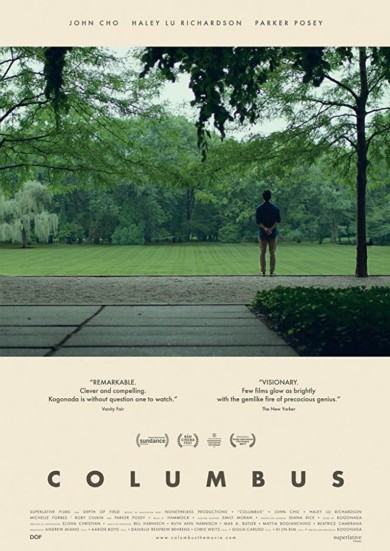Columbus
Jin (John Cho) visits his father, a renowned Korean architect, after he falls into a coma. He meets Casey (up and coming Haley Jo Richardson) a young woman with a passion for architecture. Reflective film on themes of dysfunction and friendship set against the surprising architectural heritage of a Midwestern town.
Film Notes
Yes, we’re in the territory of the small-town coming-of-age movie – but things are bound to be a little different, given that the small town is Columbus, Indiana, noted for its unusual concentration of outstanding modernist architecture. The film finds its strikingly perceptive visual bard in Korean-American director kogonada, who brings a deeply idiosyncratic stylistic and dramatic sensibility to a story that’s not just a character piece, but also a finely nuanced study of people, space and consciousness.
An ashamedly rarefied artistic approach will make for very niche appeal, but superb ensemble acting, keen intelligence and low-key but very palpable emotional impact will make Columbus an essential visit for discerning art-house buyers and programmers. It will also provide further prestige for Columbus, Indiana itself – which could probably use some good press these days, given that the town is also known as the birthplace of US vice president Mike Pence.
Korean-born, US-based kogonada is best known for his video essays, or ‘supercuts’, on directors including Stanley Kubrick, but establishes his own superbly confident, calm approach in this story about people and the buildings that bring them together.
The central character is 19-year-old working-class girl Casey (Haley Lu Richardson), recently graduated and undecided about her future. Currently working as a librarian, alongside a simpatico, cerebral friend (Rory Culkin), she’s in love with, and deeply knowledgeable about, the town’s architecture, including buildings by Eero Saarinen, James Stewart Polshek and Deborah Berke – edifices which can properly be counted among the film’s stars. Sensitive, intelligent Casey could have a career studying architecture, but feels she needs to stay at home and tend her factory worker mother (Michelle Forbes), just emerging from a troubled period.
Also in town, having flown in from Seoul, is literary translator Jin (John Cho), the middle-aged son of a visiting Korean architecture professor who has collapsed; the professor’s assistant, Yale academic Eleanor (Parker Posey), is an old flame of Jin. Cooling his heels in town while Dad is in hospital, Jin spends time with Casey, listening to her wax enthusiastic about the buildings she loves, and contemplating his own current enforced limbo. The pair bond in a way that’s intimate but non-sexual, rather like – in a muted, non-comic manner – the relationship between the Bill Murray and Scarlett Johansson characters in Lost in Translation.
Columbus is a coolly executed drama, and low on event – at one point, talking about his father’s condition, Jin comments, “This isn’t the movies. Nothing’s going to happen.” In fact, much does happen, although it often happens in spaces between scenes, or on characters’ faces. Kogonada frequently inserts this kind of wry, unobtrusive commentary on his own mode of film-making, as when Culkin delivers an intriguing disquisition on the difference between ‘attention’ and ‘interest’ (slow cinema aficionados, discuss) and after a meal seemingly low on spice, Casey comments that the result is more subtle, as not only do you savour the food properly, you also get a better aftertaste.
Appreciative viewers of Columbus will certainly appreciate an aftertaste, as its ideas and feelings resonate beautifully – not least because of kogonada’s own unconventional editing, often highlighting quasi-musical counterpoint. Elisha Christian’s superbly composed cinematography makes streets and open spaces feel eerie yet warm, suggestive of a functioning utopian space. Where it might have been easy to depict the place as a chilly hard-angled ghost town à la Antonioni, we also get telling shots of another Columbus, run-down and proletarian, existing alongside the elegance. The interiors, too, are superbly shot – notably the magnificent residence seen at the start, its straight lines evoking the grids of a Mondrian painting.
Into what might have been an alienating, hard-edged setting, human warmth comes from some relishably muted performances. Posey gives her most mature, nuanced turn to date, while Cho – worlds away from the commercial terrain of his Star Trek and the Harold and Kumar appearances – economically suggests the turbulent inner life of a saturnine, emotionally contained loner.
At the centre of the film, however, is a deeply charismatic performance by Haley Lu Richardson (recently seen in feistier mode in M. Night Shyamalan’s Split), whose Casey emerges though a plethora of ever-shifting emotional fine tunings, even though she speaks in the flat tone that’s a trademark of contemporary US youth. But it’s Richardson’s face that does so much of the work – radiant, luminous, often amused, never over-expressive but always responsive.
Above all, you really believe in Casey as a kind of character that’s only too rare in contemporary US cinema – someone who has not just an emotional life, but an intellectual one too.
JONATHAN ROMNEY, Screen Daily, 30th January 2017.
An assured and hypnotic debut from tyro writer/director Kogonada with a terrific cast.
There’s an old saying, often attributed to Martin Mull, “Writing about music is like dancing about architecture.” In many ways first-time writer/director Kogonada’s “Columbus” treats architecture like music, as its protagonists write, talk, bicker, and dance about an extraordinary collection of modernist structures in the unassuming Midwest town of Columbus, Ind. The hypnotically paced drama carried by the serendipitous odd-couple pairing of John Cho and Haley Lu Richardson is lovely and tender, marking Kogonada as an auteur to watch.
A film critic and video essayist with evident affection for the work of Asian masters ranging from Yasujirō Ozu to Hirokazu Koreeda, the mono-monikered director examines the relationships between his characters and their environment with an architect’s attention to detail. That he also trains his lens on a place and people rarely explored on film, and provides a quintet of terrific performers with the opportunity to stretch and showcase their skills, only adds to his debut’s unique appeal.
Casey (Richardson) has lived in Columbus her entire life. Fast approaching her 20s (or possibly just starting them, it’s not clear), she’s beginning to think about next steps. But a deep connection to her hometown and a strong bond with her working-class mother (Michelle Forbes, moving and lived-in), a recovering addict now in a stable place, makes Casey apprehensive about leaving to pursue her interest in architecture.
Jin (Cho) left his family behind years ago, but returns to the U.S. from his new life in Korea, where he translates literature, when his architecture professor father collapses on a visit to Columbus and is hospitalized in a coma. Although his passions led elsewhere, Jin retains a lingering guilt, and defensiveness, over his lack of family commitment.
Casey and Jin inevitably cross paths, and their casual conversations blossom into a genuine friendship, and possible a courtship. Nothing is quite so simple in “Columbus,” and Kogonada is more interested in the characters’ overlapping and divergent worldviews and dreams, based on culture, environment, and upbringing.
The pair each have a secondary confidante/love interest. Jin with his father’s colleague (Parker Posey, vibrant), on whom he nursed a crush in his youth, and Casey with hyperarticulate Doctoral student Gabriel (Rory Culkin, charming). At one point Gabriel delivers a spellbinding dissection of the modern attention span, suggesting Kogonada is aware of the material’s ponderous nature and specialized audience appeal.
But those who appreciate “Columbus” will likely take it to heart. The relationships between each of the characters are imbued with warmth and humanity, and the filmmaking — like the city’s structures designed by the likes of Eero Saarinen and I.M. Pei — is simply gorgeous.
The modernist landmarks in Columbus (incidentally the hometown of Vice President Mike Pence) are true co-stars here. Casey’s appreciation of the “healing power” of buildings stirs something in Jin that never quite connected when he was with his father (although it’s surely no coincidence their bond coincides with his father’s coma), and the film’s gentle explorations of class divides — we’re constantly reminded of the people trying to make a living inside of these works of art — qualify as a timely addition to the current national dialog.
But Kogonada, who also serves as the editor, has also made a film that feels timeless. From Elisha Christian’s rigorously composed cinematography to Hammock’s sparingly but very effectively used ambient electro score (the film gets just as much emotion out of stretches of silence and layered sound design).
At the center of it all, amid the buildings, are Cho and Richardson. One veteran demonstrating his untapped ability as a captivatingly sincere leading man, and one relative newcomer proving her ability of holding the screen with maximum soulfulness in a minimalist drama. Together they form an unexpected, but perfectly constructed, pair.
Geoff Berkshire, Variety, 29th January 2017.
What you thought about Columbus
Film Responses
| Excellent | Good | Average | Poor | Very Poor |
|---|---|---|---|---|
| 13 (50%) | 11 (42%) | 2 (8%) | 0 (0%) | 0 (0%) |
|
Total Number of Responses: 26 Film Score (0-5): 4.42 |
||||
Collated Response Comments
We have registered 109 as the number of members who watched the film all the way through.
Also it has been noted that some members have had difficulty making the links work and there will be more information in the next Newsletter about how to obtain the best viewing experience.
Here are all of the comments collated from the website and elsewhere.
“Enjoyed the film but it was bit slow in places. The face-on camera angle, like a photograph, was effective in bringing atmosphere to the interiors and other spaces. Liked the slow development of revealing the nature of the relationships between the various characters. The discussion threads on architecture, attention span/interest, familial and cultural issues were all handled in a beautifully subtle way. Columbus is a pretty deserted place - did they do the filming at 5.00 in the morning? Thanks again for the streaming”.
“Well we stuck out the slow start and gradually the film engrossed us – two people both grappling with difficult parental relationships coming together against the serene backdrop of the clean-cut buildings. Once again, a lovely diversion from the horrors of Corona Thankyou”
“Clearly filmed by someone with a passion for geometry, all the scenes were visually exquisite. But I’m afraid I didn’t connect with the people at all and concluded that it would have been better to watch it with sound and subtitles off”.
“Casey and Jin congealed the story of their personal lives and of architecture with much curiosity. The filming of some of the modern buildings in Columbus, Indiana was really stimulating to see the use of light, structure and the uses of these buildings. It would have been interesting to hear Casey telling Jin about her thoughts on architecture as well as to have seen filmed more renowned buildings in this infamous city of modern architecture. Casey and Jin were certainly strong characters portrayed in the film and the supporting cast made their roles shine. Excellent film to watch in the current environment. PS Thank you for the introduction to the start of the film”.
“Just a quick thank you to all who are making it possible to watch our programmed films at home. 'The Rider' came at a time when it was marvellous to just lose oneself in the magnificent landscape, but how much better it would have been on a big screen! Still, perhaps it could be shown at the Film Festival (looking on the positive side!) Columbus was superb too, the amazing buildings making up for big holes in the story-telling. Thanks again”.
“Really enjoyed this film even though I was not expecting to! Sensitive throughout & the characters were all believable. Great actors. The direction made it so believable that the young woman, Casey, would be interested in architecture. The framing of shots made the film easy and visually appealing to watch. Thank you, a second good isolation Tuesday film!,
"Thanks again, GFS, for live streaming this unusual film (unusual for an American film). I thought the film was good. Although the pace was slow I thoroughly enjoyed the film. The acting was excellent. The backdrop of Modernistic architecture was very interesting. (Reminded me of a visit to 'The Homewood', Patrick Gwynne's Modernist house near Esher (National Trust.)"
“I ended up watching, ' Columbus' on Amazon Prime without sub titles, I would say that the subtitles were very necessary as I found it really hard to know what on earth they were talking about at the start of the film! Ultimately, I loved the film. Haley Lu Richardson was a revelation. The cinematography was superb and as for the architecture, mind blowing! Columbus, Indiana is now on my bucket list of travel. The interior shots reminded me of Dutch paintings and the soundtrack by Hammock, perfect and very atmospheric”
“Thanks so much for screening the remaining films. Ended up watching on iPad as couldn't get to work on Smart TV but was still able to enjoy it despite the small screen! The main characters, Casey and Jin, and their evolving relationship were very engaging and although not a fast moving film it was strangely involving and watchable. The filming was good too with the focus on the architecture and its part in the story”.
“Jin and Casandra shared some life experiences whilst feeling very different about them. So, whilst they mirrored each other's life in some aspects, in others one was a mirror into the other's life”.
“Visually a treat but unfortunately we could not view it all as it froze half way through and just buffered. Pity”.
“A beautifully shot, gently paced and charming coming of age film with great performances by Haley Jo Richardson and John Cho developing a really good and largely platonic relationship. A good film for these times; calm, thoughtful and uplifting”.
“Once one geared down to the snail's pace this was an absorbing tale of a young woman's development from confused if dutiful youngster to an appreciation of her self-worth and ability, and the decision to take perhaps her only opportunity to realise herself. Contrast Casey with Jin, the intelligent son of a successful family but with the classic inability to make a worthwhile path for himself. Casey's role reversal with her mother, the parent to her mother's child, was very sympathetically and vividly depicted, likewise her interaction with the geeky librarian, where from supplicant she quickly learns to appreciate her own worth, and the more nuanced, growing appreciation by Jin of her qualities. All of course is in the visual context of singularly unattractive architecture, to this viewer at least, with the exception of the Bank. Like all good art, the more I reflect on Columbus, the more it gives me. Snail’s pace? Tick. Brutalist yet thoughtful buildings? Tick. Good choice, GFS”.
“Another slow and languorous film (it's as if the GFS committee knew lockdown was coming and planned to get us all to take it easy...!), but this one was much more satisfying than The Rider. I wasn't sure to begin with, but the film grew more intriguing and emotionally stronger as it went on. The cinematography was excellent, and Haley Lu Richardson gave another excellent performance”.
“I loved the slow, reflective pace and the Edward Hopper/Yasugiro Ozu atmosphere. A very interesting and thought provoking film”.
“Became more fascinated by the film as it developed. For a first feature directed by Kogonada, the use of known works of modern architecture alongside a young adult's coming-of-age and a new friendship developing in difficult circumstances was handled with real skill. But it's hard work to watch in many ways because of the slowness of it. Visually precise, the camera rarely moves and we look how the buildings in background established the mood of a scene. Was fascinated by the striking clocks, the water metaphors and the use of framing. The filming of contrasting lines of the city's avant-garde buildings and their sharp edges, has a curious attention to detail. Wondered if the relationship between symmetry and asymmetry underpinned both image and narrative? Jin's emotionally trapped by being away from his ailing father while Casey is, by contrast, suppressed by her devotion to her mother. What Kogonada does so well is to develop this unlikely friendship between Casey, and Jin, as they visit Columbus' architectural landmarks. Pretty soon, they're discussing the building's asymmetrical symbolism which brings them closer. Liked Gabriel, the clever librarian, especially when he asks Casey, "Are we losing interest in everyday life?" Does he love her? He does delicately retreat from Casey when she opens up to him. Will Casey miss Columbus and her mum? A complex but satisfying film – is it about symmetry and asymmetry in many things?”
“Is this the Covid-19 effect? That I can enjoy a film so much that moves so gently and in which momentous events turn so quietly and convincingly? Both the leads are excellent, tangled in the fetters of family, Jin scratchy and distanced, Casey with amused resignation. Richardson as Casey is a revelation, her face registering the alternating conflict of emotions, always with an ironic humour and bright intelligence. The gradual evolution of their bond is tenderly drawn, reminiscent of Murray and Johansson in 'Lost in Translation' and Hutton and Portman in 'Beautiful Girls'. The film is stunningly designed, its straight lines and elegant proportions an homage to the architecture of the city which the characters sit within like Vermeer portraits in gentle backlit tones. An effectively understated score too.
BTW - you can register two views for this as Calum and I both watched it on my computer”.
“Streaming wasn't as smooth tonight. I was watching on a Smart TV and it didn't want to switch over from the spoken introduction to the main movie. So I switched to a laptop and watched it via that on the larger TV screen. Excellent movie though”.
“We very much enjoyed this second streaming from GFS. My first comment on the Film would be praise for the architectural quality of the frames throughout. By this I do not mean any particular reference to the individual architectural buildings but the actual format of each shot. Whether this was in Casey's home or the elegant inn where Jin was staying each shot was carefully and beautifully composed along architectural lines. Interesting shots in particular were down the hallway of Casey's home and the scene where Jin and Eleanor were talking framed within a mirror. One thing in particular I noticed was that we never had a full face shot of her Mother - most times it was a back or side view and only at the end when they were in bed did we see more of her face. There was a strong element of calm to the film. I have worked in a library and can attest to the almost "religious retreat" like calm which descends on you after several hours in a silent space. The modern house at the start and end of the film also gave a sense of Zen like peace with its wide windows and displays of art and cool marble floors. I found the one jarring note was when Casey turned on the music in the car and danced in the street. I assume this was because she was very concerned about her Mother but it did not seem to fit in with the general atmosphere of the film.
I know nothing of America first-hand but was very impressed with Columbus with its interesting buildings and manicured lawns. I would be interested to visit but know I will never do so. However I can imagine a number of GFS members are already planning their next holiday and like me may have looked up The Inn at Irwin Gardens for possible accommodation -see link -https://www.irwingardens.com. I hope they won't keep dropping cigarette ends everywhere though. The film was certainly not encouraging healthy living from this point of view.
I am glad there was no obvious romantic interest for Casey either with Jin or Gabe as I think this would have brought the film into the realm of the ordinary. Much better to just leave it hanging in the air”.
“This couldn't have been more different from last week's film: beautiful, elegant settings, articulate characters, a focus on art (in the form of architecture). Slow, quiet, largely uneventful, but still gripping, most of the interest arising from the fact that all the characters seemed to be in some sort of limbo - we waited anxiously to see whether, like the father in his coma, they would 'die' or 'survive'. Excellent, subtle (a key word) performances all round”.
“Failed to connect tonight but found the film on Amazon Prime. Enjoyable, enjoyed the architecture stuff”.
“Such a treat - film, architecture, the indie-ness of it! Loved the careful composition of each scene, and the overlapping almost subliminal soundtrack, and the dialogue/non-dialogue sequences (Hartley-esque). This is a thoughtful, inventive director/writer/editor, and a cinematographer (Elisha Christian) to keep an eye on (literally!). Haley Lu Richardson also one to watch as I thought her nuanced performance was astounding”.
“Fantastic film, full of breathtaking images and tranquil settings contrasting the pain of separation experienced by the main characters. Very satisfying”.
“



